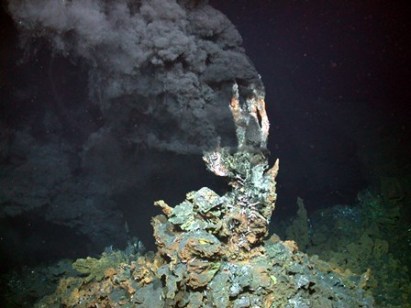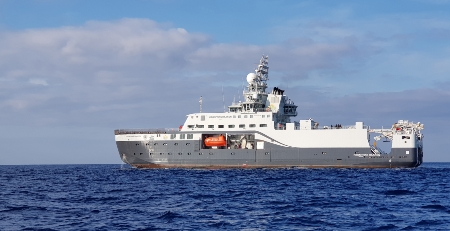What is a hydrothermal vent?
 A hydrothermal vent in the Mid-Atlantic Ridge (photo by: MARUM, Germany).
A hydrothermal vent in the Mid-Atlantic Ridge (photo by: MARUM, Germany).
Link to YouTube video from NOAA: VENT VIDEO
Hydrothermal vents are found where 2 tectonic plastes are being pulled apart and new seafloor is being made. There, the cold sea-water penetrates trough cracks in the crust and as it gets close to the magma chamber, it heats up and incorporates minerals. The hot fluid rises back to the top and when it comes out and gets in contact with the cold and oxygenated water, the metals precipitate, giving the impression of black smoke, This is in reality very hot fluid (350 C) charged with minerals, that fall down to the seafloor forming tall chimneys (as tall as 40 meters!).
Who lives there?
The animals at hydrothermal vents are unique and exotic. Many of them have large amounts of bacteria associated with their bodies which provides all their food (like for the tubeworms or shrimp in the photos below) or part of their food (like for the mussels). The bacteria use the energy in the chemicals found in the hydrothermal fluids to produce organic matter (chemosynthesis), in the same way that the plans use solar energy (photosynthesis). This mutually relationship between the animals and bacteria is called symbiosis.
Photos:
- Tubeworms Riftia pachyptila from the Pacific (Cindy Van Dover, Duke Uni.).
- Mussels Bathymodiolus and shrimps Rimicaris exoculata from the Atlantic (Cruise SEHAMA, 2002 (FCT, PDCTM 1999/MAR/15281), VICTOR6000/IFREMER).
- Dumbo octopus and a zoarcid fish and a crab over tubeworms in the Pacific (E. Kristof, National Geographic).
Norwegian icebreaker Kronprins Haakon
 The HACON team will sail on the new Norwegian icebreaker Kronprins Haakon (photo Ø. Mikkelborg, NPI) in September-October 2019 to investigate the Aurora vent field at 4000 m depth under ice in the Gakkel ridge.
The HACON team will sail on the new Norwegian icebreaker Kronprins Haakon (photo Ø. Mikkelborg, NPI) in September-October 2019 to investigate the Aurora vent field at 4000 m depth under ice in the Gakkel ridge.




